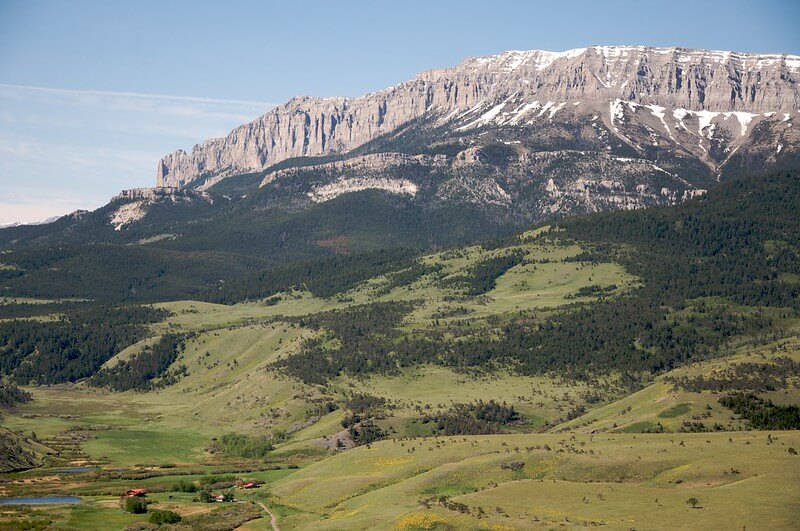Surfing the Reef of the Rocky Mountain Front
by Heather McCartney-Duty
Broadcast 8.31 & 9.3.2021

The Rocky Mountain Front, photo by Sam Beebe, CC 2.0.
Listen:
The sun breaks the eastern horizon, gleaming like a red laser across the calm sea. The waves lap gentle against the shore, ebbing and flowing, with a gentle whoosh, crash and retreat.
Dragonflies begin their hunts, scouring quiet tidal pools for tasty breakfasts while beneath the waters trilobites and brachiopods scour the sea for their sustenance of “little shellys.”
The humid air stirs and the ferns and new conifers wave. The mosses, per usual, remain too dignified to move.
The day has begun on this reef…300 million years ago, give or take a millenium.
Today, I stand in the same early morning sunlight but on dry ground, looking up and west at what the Blackfeet call the “Backbone of the World,” the Rocky Mountain Front. I tip my head all the way back to look way up at this reef, now transformed by time. No longer a watery ecosystem, this stalwart limestone history book is now covered in the latest versions of conifers and alpine short grasses. A reef can be formed many ways, through biotic and abiotic processes. The structure as we know it today is often a substantial mostly barren rock slab, formed either of coral and other sea life skeletons, or by sand deposition, just above or below sea level. But the only sea here today is one of rolling hills of prairie grass stretching as far to the east as the eye can see.
Shades of bone and eggshell reflect brightly in the morning sun. It feels as if the sheerness of the rock face shouldn’t be holding anything, yet here in my binocular’s view is a nanny mountain goat, leading her kid out for a graze on the wall.
I kneel and sort through the stones at my feet, ground by ancient glaciers, flipping them over, looking and feeling for the prize of raised or sunken ridges in a geometric pattern. I find several imprints of crustaceans and pick them up—giddy with the find of an ancient clam.

Aerial photo of the Lewis Overthrust; the easternmost (right) portion is the Rocky Mountain Front. The waterbody is Gibson Reservoir, west of Augusta, Montana. Photo by Bobak Ha’Eri, CC-by-SA-3.0.
The stone faces that rise above me are still called reefs after all this time, and they retain many of their original inhabitants, though now in layers of inanimate fossil and mineral. They have been named: Castle, Walling, Split, and famously, The Chinese Wall. The reefs, formed in the Paleozoic Era, still give life to land-dwelling flora and fauna, providing a strong foundation for the roots of living plants as well as dissolved nutrients for a variety of plant and animal life.
As to why these reefs, made primarily of Mississipian or Cambrian limestone, are so high and exposed, we have a few clues from their immediate mountainous neighbors to the west, the Madison limestone overthrust belts. Things like massive marine deposits tend to get shoved out of their comfortable ancient seabed when layers of the earth’s crust collapse and fold with the colliding of the tectonic plates.
Over the centuries, with each rain and snowfall on this arid set of slabs, nutrients—primarily calcium from the bodies of ancient fossilized creatures—wash down its walls into small trickles and cold mountain streams that feed the high plains. Whole boulders, under the power of wind, water, and ice, dislodge and tumble down to the plains. Under glaciers from the last ice age, many were crushed and ground and pulverized into chunks and rocks and powders that form the growing medium of the Rocky Mountain Front.
Ancient life nourishes life today. I take a roast elk sandwich from my pack and take a moment to marvel at the massive landscape and express gratitude: for the ungulate that fed upon the grasses that absorbed the minerals that the reef shed after the marine life perished and aged on this glacial plain. This is the House (of Sky), as writer Ivan Doig penned, that the sea built.
Every week since 1991, Field Notes has inquired about Montana’s natural history. Field Notes are written by naturalists, students, and listeners about the puzzle-tree bark, eagle talons, woolly aphids, and giant puffballs of Western, Central and Southwestern Montana and aired weekly on Montana Public Radio.
Click here to read and listen to more Field Notes. Field Notes is available as a podcast! Subscribe on iTunes, Google Play, or wherever you listen to podcasts.
Interested in writing a Field Note? Contact Allison De Jong, Field Notes editor, at adejong [at] montananaturalist [dot] org or 406.327.0405.
Want to learn more about our programs as well as fun natural history facts and seasonal phenology? Sign up for our e-newsletter! You can also become a member and get discounts on our programs as well as free reciprocal admission to 300+ science centers in North America!












